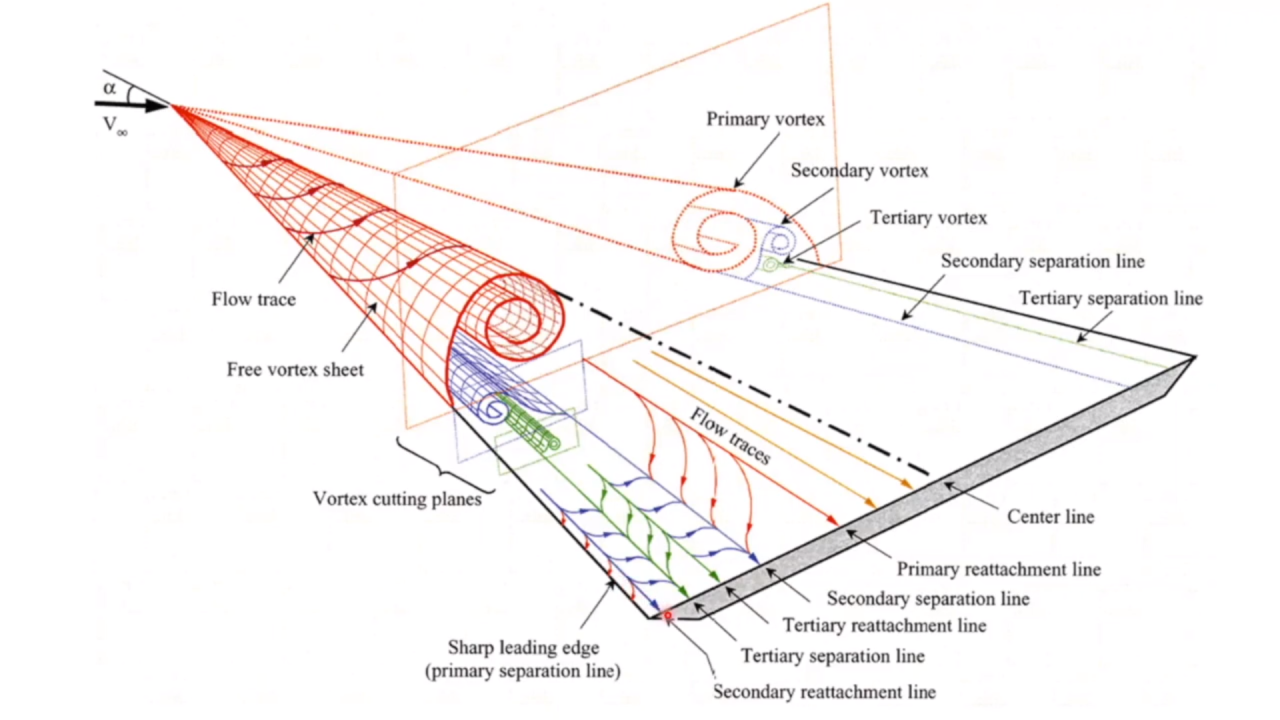
Vortex Traces on a Delta Wing, Surface Flow visualization Vortex Prediction
Vortex Traces on a Delta Wing, One of the interesting image in terms of aerodynamics. This is the suction side of delta wing, We can see main primary vortices in red, being generated from pressure side of the wing to the suction side.
Using the surface flow visualization technique, we can't see vortex as it is an off body flow structure far away from the surface. What we can see, it's effect on boundary layer that can help us to locate these vortices.
Surface flow visualization reveals the flow streamlines in the limit as a solid surface is approached. Colour oil applied to the surface of a wind tunnel model provides one example (the oil responds to the surface shear stress and forms a pattern).
Vortex rotation generate primary reattachment lines, that could be seen in flow trace visualization. If we see that kind of traces(reattachment lines), we can predict core of the vortex is bit offset at a certain distance from the surface.
As vortex is shedding through edge, there will be more vortex shedding in the opposite sense, it will grab the boundary layer and shed it in opposite sense. So it will going to have a secondary separation line as we can see in the above image.
It will also have a secondary reattachment line which is an area close to tangent to the surface. If in our flow visualization techniques, resolution is good enough we can see tertiary vortex trace as well.
We can see the width of the traces, for the primary vortex, it is the biggest and it should be as the primary vortex is the biggest one. Based on the surface flow visualization traces pattern we can predict the location of vortex.
Between Primary reattachment and Secondary separation line, Somewhere between these two lines and at a distance from the surface would be the location of primary vortex.
Finally Flow visualization can give us hint to predict the location of vortex offset to the surface.
Downside is that the transient nature of vortex shedding can make things complicated. It could be sometime difficult to predict the condition at which vortex is being shed because we are trying to study surface flow visualization, a dried paint one. Sometime we just simply don't know at what condition paint got dried.

Professor at INSTITUTE OF AERONAUTICAL ENGINEERING
3yExcellent analysis
CFD Specialist | Thermal and Fluids Consultant | Free Mentoring | LinkedIn Top Contributor | Follow on Linkedin
3yGood writing bro... 💫
Hadar Ben-Gida
Senior Researcher at Institue of Space Technology
3ySenior Researcher at Institue of Space Technology
3y